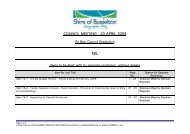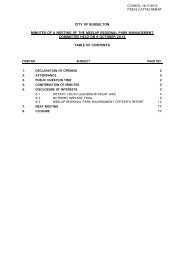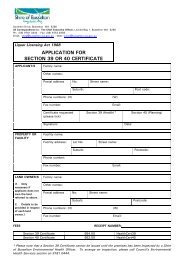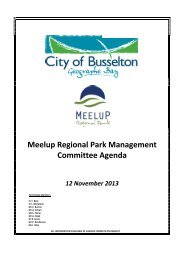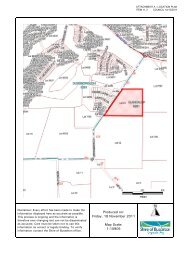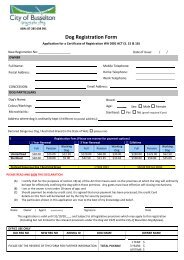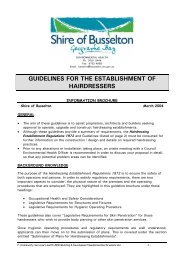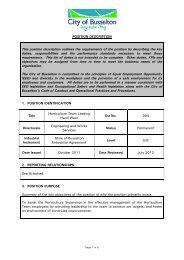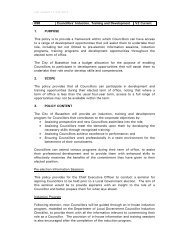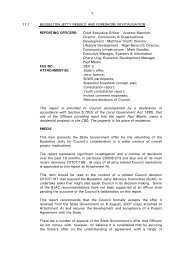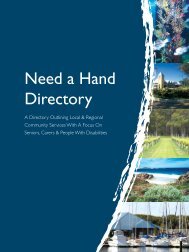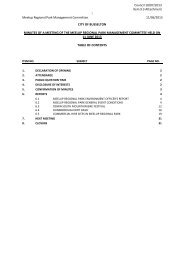Attachments 11.4 and 11.5 - City of Busselton
Attachments 11.4 and 11.5 - City of Busselton
Attachments 11.4 and 11.5 - City of Busselton
You also want an ePaper? Increase the reach of your titles
YUMPU automatically turns print PDFs into web optimized ePapers that Google loves.
LAND inSights<br />
ATTACHMENT A – DRAFT LEPS ITEM <strong>11.5</strong> COUNCIL 12/10/2011<br />
Executive Summary<br />
littoralis <strong>and</strong> species formerly known as Dry<strong>and</strong>ra spp.), Hakea spp., <strong>and</strong> Agonis spp.<br />
Also includes pine plantations <strong>and</strong> cape lilac.<br />
Breeding habitat - Potential nest trees are any Marri (C. calophylla), Jarrah (E.<br />
marginata), Black Butt (E. patens), Flooded Gums (E. rudis), Tuart (E. gomphocephala)<br />
or W<strong>and</strong>oo (E. w<strong>and</strong>oo) (either alive or dead stags) with a Diameter Breast Height <strong>of</strong><br />
more than 500 mm.<br />
Roosting habitat - Generally prefer large st<strong>and</strong>s <strong>of</strong> tall trees close to permanent water,<br />
with dense canopy. Tree species used for roosting include Marri (C. calophylla), Jarrah<br />
(E. marginata), Tuart (E. gomphocephala), W<strong>and</strong>oo (E. w<strong>and</strong>oo), introduced eucalypts<br />
<strong>and</strong> introduced pines.<br />
The distribution <strong>of</strong> threatened fauna is fairly even throughout the western section <strong>of</strong> the Shire<br />
<strong>and</strong> the northern coastal area. In general, threatened fauna are typically located where<br />
remnant vegetation is present (<strong>and</strong> therefore habitat is still available). However, it should be<br />
noted that although a large area <strong>of</strong> vegetation exists in the eastern section <strong>of</strong> the Shire, a very<br />
small number <strong>of</strong> threatened fauna are found in this area.<br />
Other biodiversity assets<br />
Threatened Ecological Communities (TEC’s) are communities which consist <strong>of</strong> native<br />
vegetation which are poorly represented <strong>and</strong> in danger <strong>of</strong> extinction. Ten threatened ecological<br />
communities are known to be present in the Shire. The DEC database also indicates that 22<br />
taxa <strong>of</strong> Declared Rare Flora <strong>and</strong> 69 taxa <strong>of</strong> Priority Flora are present in the Shire. 160 taxa are<br />
at the end <strong>of</strong> their range on the <strong>Busselton</strong> Plain, with 60 <strong>of</strong> these being at the northern end <strong>of</strong><br />
their range <strong>and</strong> 35 at the southern end (DEC, 2009).<br />
Dieback<br />
‘Dieback’ is the common name given to the pathogen Phytophthora cinnamomi. It is a soil<br />
borne water mould which invades <strong>and</strong> destroys the root systems <strong>of</strong> many native species in<br />
Western Australia. The ease with which the pathogen can spread has greatly contributed to its<br />
extensive occurrence <strong>and</strong> consequent destruction <strong>of</strong> large areas <strong>of</strong> native vegetation in<br />
Western Australia. Therefore, it is important that areas <strong>of</strong> vegetation that are susceptible to<br />
dieback are closely monitored for signs <strong>of</strong> infection, the soils are tested <strong>and</strong> that if dieback is<br />
found, measures are put into place to prevent its further spread. A report prepared by the<br />
Dieback Working Group in 2000 called Managing Phythophthora Dieback, Guidelines for Local<br />
Government contains advice on how dieback can be managed.<br />
Fire risk<br />
Fire is a natural occurrence in the Australian environment, with some vegetation communities<br />
<strong>and</strong> species relying on the occurrence <strong>of</strong> fires for continued growth <strong>and</strong> regeneration.<br />
However, it is important that fire prevention <strong>and</strong> management is promoted in order to reduce<br />
the impact <strong>of</strong> fires on human safety <strong>and</strong> on the natural environment (WAPC, 2001).<br />
Fire management can have negative effects on vegetation composition <strong>and</strong> fauna if undertaken<br />
inappropriately intervals/times. Major issues associated with fires that can have a negative<br />
VER 1 – FINAL DRAFT<br />
Shire <strong>of</strong> <strong>Busselton</strong> Local Environmental Planning Strategy<br />
Report 3 – Objectives, Strategies <strong>and</strong> Actions<br />
November 2010<br />
Page 26



